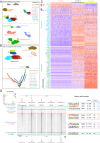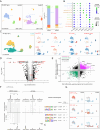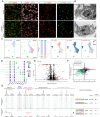CEBPA restricts alveolar type 2 cell plasticity during development and injury-repair
- PMID: 38755149
- PMCID: PMC11099190
- DOI: 10.1038/s41467-024-48632-3
CEBPA restricts alveolar type 2 cell plasticity during development and injury-repair
Abstract
Cell plasticity theoretically extends to all possible cell types, but naturally decreases as cells differentiate, whereas injury-repair re-engages the developmental plasticity. Here we show that the lung alveolar type 2 (AT2)-specific transcription factor (TF), CEBPA, restricts AT2 cell plasticity in the mouse lung. AT2 cells undergo transcriptional and epigenetic maturation postnatally. Without CEBPA, both neonatal and mature AT2 cells reduce the AT2 program, but only the former reactivate the SOX9 progenitor program. Sendai virus infection bestows mature AT2 cells with neonatal plasticity where Cebpa mutant, but not wild type, AT2 cells express SOX9, as well as more readily proliferate and form KRT8/CLDN4+ transitional cells. CEBPA promotes the AT2 program by recruiting the lung lineage TF NKX2-1. The temporal change in CEBPA-dependent plasticity reflects AT2 cell developmental history. The ontogeny of AT2 cell plasticity and its transcriptional and epigenetic mechanisms have implications in lung regeneration and cancer.
© 2024. The Author(s).
Conflict of interest statement
The authors declare no competing interests.
Figures







Update of
-
CEBPA restricts alveolar type 2 cell plasticity during development and injury-repair.bioRxiv [Preprint]. 2023 Oct 12:2023.10.10.561625. doi: 10.1101/2023.10.10.561625. bioRxiv. 2023. Update in: Nat Commun. 2024 May 16;15(1):4148. doi: 10.1038/s41467-024-48632-3. PMID: 37873326 Free PMC article. Updated. Preprint.
-
CEBPA restricts alveolar type 2 cell plasticity during development and injury-repair.Res Sq [Preprint]. 2023 Dec 14:rs.3.rs-3521387. doi: 10.21203/rs.3.rs-3521387/v1. Res Sq. 2023. Update in: Nat Commun. 2024 May 16;15(1):4148. doi: 10.1038/s41467-024-48632-3. PMID: 38168395 Free PMC article. Updated. Preprint.
References
MeSH terms
Substances
Grants and funding
- R01 HL130129/HL/NHLBI NIH HHS/United States
- P30 CA016672/CA/NCI NIH HHS/United States
- R01HL153511/U.S. Department of Health & Human Services | National Institutes of Health (NIH)
- R01 HL153511/HL/NHLBI NIH HHS/United States
- R01HL130129/U.S. Department of Health & Human Services | National Institutes of Health (NIH)
LinkOut - more resources
Full Text Sources
Molecular Biology Databases
Research Materials
Miscellaneous

